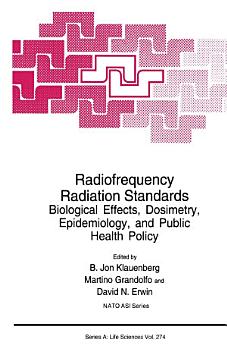Radiofrequency Radiation Standards: Biological Effects, Dosimetry, Epidemiology, and Public Health Policy
B. Jon Klauenberg · Martino Grandolfo · David N. Erwin
nov 2013 · NATO Science Series A Libro 274 · Springer Science & Business Media
5,0star
2 reseñasreport
eBook
456
Páginas
reportLas valoraciones y las reseñas no se verifican. Más información
Información sobre este eBook
The North Atlantic Treaty Organization (NATO) has sponsored research and personnel safety standards development for exposure to Radiofrequency Radiation (RFR) for over twenty years. The Aerospace Medical Panel of the Advisory Group For Aerospace Research and Development (AGARD) sponsored Lecture Series No. 78 Radiation Hazards,! in 1975, in the Netherlands, Germany, and Norway, on the subject of Radiation Hazards to provide a review and critical analysis of the available information and concepts. In the same year, Research Study Group 2 on Protection of Personnel Against Non-Ionizing Electromagnetic Radiation (Panel VIIl of AC/243 Defence Research Group, NATO) proposed a revision to Standardization Agreement (STANAG) 2345. The intent of the proposal was to revise the ST ANAG to incorporate frequency-dependent-RFR safety guidelines. These changes are documented in the NATO STANAG 2345 (MED), Control and Recording of Personnel Exposure to Radiofrequency Radiation,2 promulgated in 1979. Research Study Group 2 (RSG2) of NATO Defense Research Group Panel VIII (AC1243) was organized, in 1981, to study and contribute technical information concerning the protection of military personnel from the effects of radiofrequency electromagnetic radiation. A workshop at the Royal Air Force Institute of Aviation Medicine, Royal Aircraft Establishment, Farnborough, U. K. was held to develop and/or compile sufficient knowledge on the long-term effects of pulsed RFR to maintain safe procedures and to minimize unnecessary operational constraints.
Valoraciones y reseñas
5,0
2 reseñas
Valorar este eBook
Danos tu opinión.
Información sobre cómo leer
Smartphones y tablets
Instala la aplicación Google Play Libros para Android y iPad/iPhone. Se sincroniza automáticamente con tu cuenta y te permite leer contenido online o sin conexión estés donde estés.
Ordenadores portátiles y de escritorio
Puedes usar el navegador web del ordenador para escuchar audiolibros que hayas comprado en Google Play.
eReaders y otros dispositivos
Para leer en dispositivos de tinta electrónica, como los lectores de libros electrónicos de Kobo, es necesario descargar un archivo y transferirlo al dispositivo. Sigue las instrucciones detalladas del Centro de Ayuda para transferir archivos a lectores de libros electrónicos compatibles.







